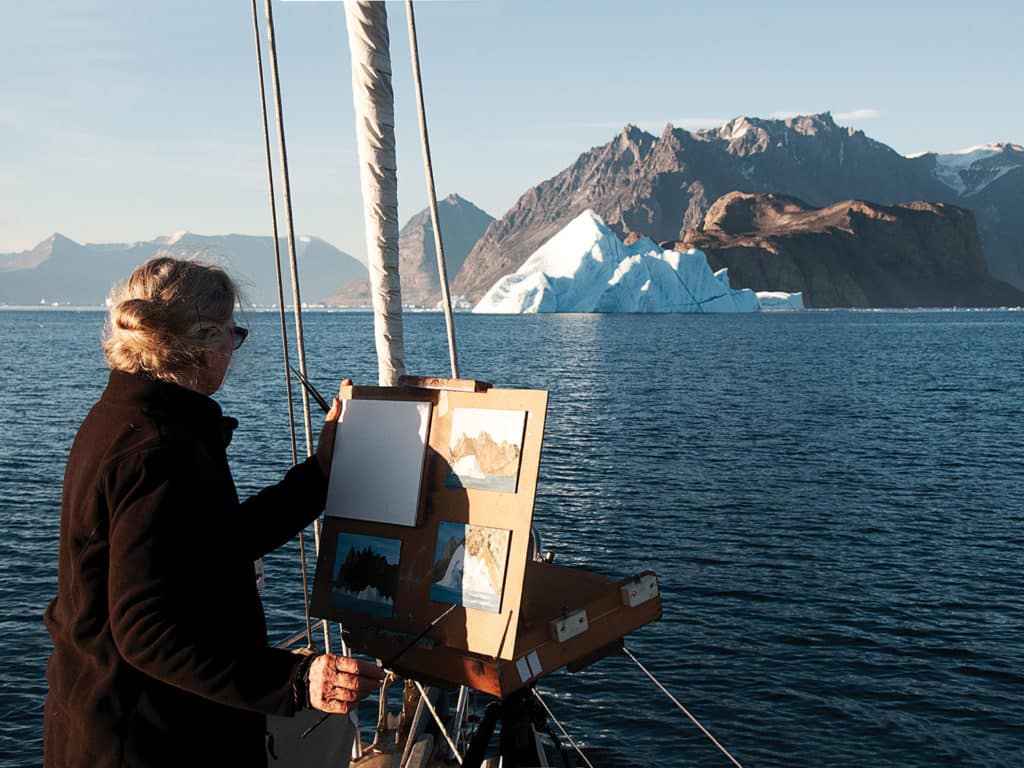
The resident artist aboard, my wife, Nancy, paints with oils, which at times creates unusual challenges as we fling and bash Francis B between Georgia’s marshlands, Labrador’s fjords, and the icebergs and mountains of Greenland. The search for the most visual impact often contradicts traditional rules of safety and seamanship, and frequently sets our course as much as the weather and season.
On the western side of the North Atlantic, the North American coastline varies from the low country of the south to the mountainous Maritimes—so our practices (or malpractices) change accordingly with the latitude.
In the long tidal river that cuts far into the west side of Ossabaw Island in Georgia, we drop anchor a few yards from the edge of a marshy plain. I double-check the weather forecast to make sure a veering or backing wind won’t put our Mason 44 ashore when the fast tidal flow slacks and the boat swings. The tide is low, down some 7 feet. Above the Spartina grasses, we can barely see scattered middens of solid ground sprouting palm trunks with their unruly moplike fronds. For a painter, this low-slung coastal wilderness demands a close approach to achieve the most-rewarding effect. The best view is from up on the spreaders, so I crank Nancy, armed with a sketchpad and locked safely in a bosun chair, aloft until she calls, “That’s high enough.” She roughly sketches the scene, then calls to come down. It’s February, and up on the spreaders it feels really cold. Just before sundown, I go up the mast to catch the best colors of the day. I take photos of the marsh hues shifting from golden to saturated red; the distant forest a smear of cold blue.
Before the next cold front arrives, we move into a confluence of four creeks where trees will protect us from gusty winds. We have a noisy night of rainsqualls, and in the morning, we row the dinghy, and then pole it, into a thread of water under overhanging branches. Night herons, blue herons and snowy egrets keep a wary eye on us but stay put above; it’s a rare chance for Nancy to sketch these birds at such close quarters.
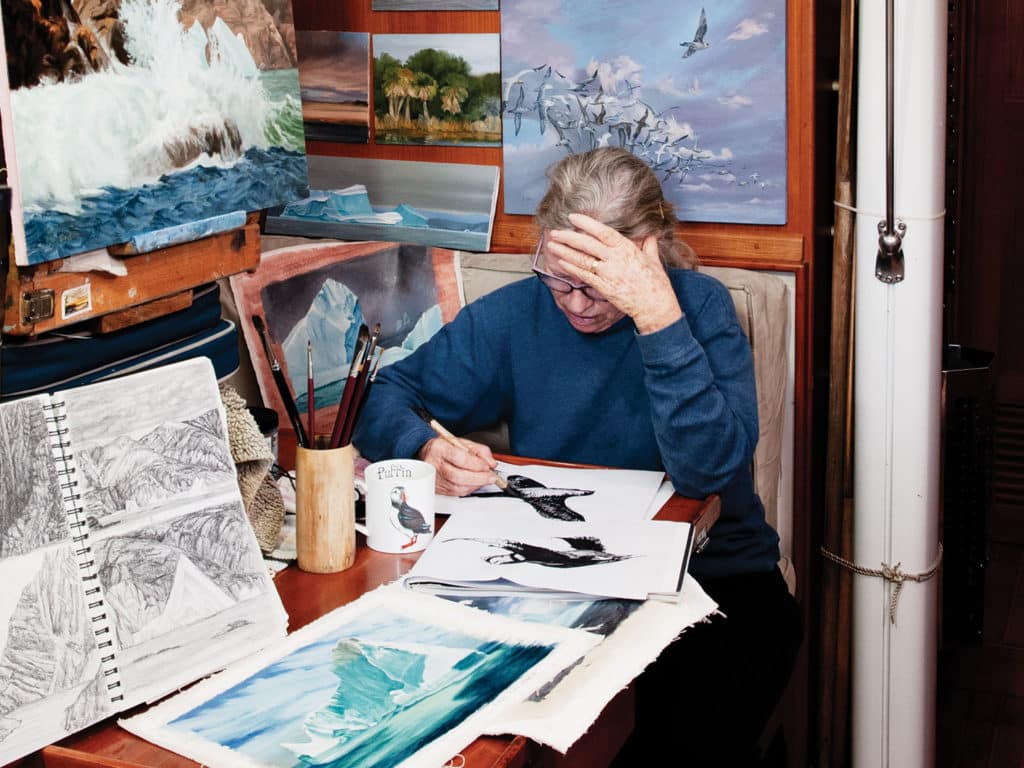
Totally different birds keep us company as we escape offshore from the first hot days in May. In coastal waters, grand elegant gannets pierce the sea head first, feeding on the way north to their summer haunts. A couple of days later, the southerly wind picks up. We increase our distance from the North Carolina headlands, and the seas grow. Shearwaters arrive, racing over the troughs and crests, their wing tips all but touching the water but never tripping the flyers. From now on, these birds will be around us. True natives of the oceans, they pass us within arm’s length. Nancy’s portfolio of birds on the wing thickens as do my own photo files.
With just two of us aboard, our on-watch/off-watch schedule and all kinds of weather thwart Nancy’s artistic efforts. In rough foaming crests, spray flying, I offer to tie her to the mast so she can experience nature’s powers; just as J.M.W. Turner, the greatest of painters of the sea, had reputedly done. Her response is not really printable. Besides, the most dramatic shorelines are so far ahead we rush northward, weather permitting.
On these passages, a stop in Gloucester, Massachusetts, has become a routine, to provision, refuel and, most importantly, to drop into the North Shore Art Association to see the latest trends.
Nova Scotia flies by if winds cooperate; Bras d’Or Lake and Cape Breton come next. In a fever to reach the rugged mountainous coast of Labrador, only foul contrary weather can stop us on the west coast of Newfoundland.
In a fever to reach the rugged mountainous coast of Labrador, only foul contrary weather can stop us on the west coast of Newfoundland.
“Look at this.” I point to Wyatt Harbour. Sheer scarps surround a small basin within the larger bay. A short pass leads in, narrow but manageable until, midway through, we look down. On both sides, rock slides, plainly visible in translucent water, angle down into deeper blue. The channel now is very tight. Inside the basin, we crane our necks up to take the measure of the tremendous wall before us: dry-blood red, amber and bronze browns in folds and shelves, and colossal boulders of igneous rock. It’s a dramatic background to an amphitheater of slightly flatter bedrock across the cove. Our anchorage, a pool of unruffled calm, reflects the mountain hues with even more intensity.
The Labrador ice loosens considerably by the end of June. We wiggle our way into Davis Strait. Having to heave to for 10 hours in rough water is the price of the passage to Greenland. At the beginning of July, our boat lies secure from all but the smallest bits of ice in Fortune Bay, between tremendous inaccessible mountainous buttes on Disko Island and an isthmus of boulders overlooking Disko Bay. Nancy takes her easel to shore and clambers up and down over the rocks, happy to paint on a stable piece of earth.
Icebergs from the glaciers breaking into Disko Bay drift by day and night. They are monumental fortresses of ice. Stately and indestructible though they look, they seem to be alive, their moves unpredictable. Nancy works under a veil of mosquito netting. The black flies are terrible in the calm, sunny weather. She has almost finished a complex oil sketch, when her model whirls around and then capsizes; a two turreted island now a smooth icescape.
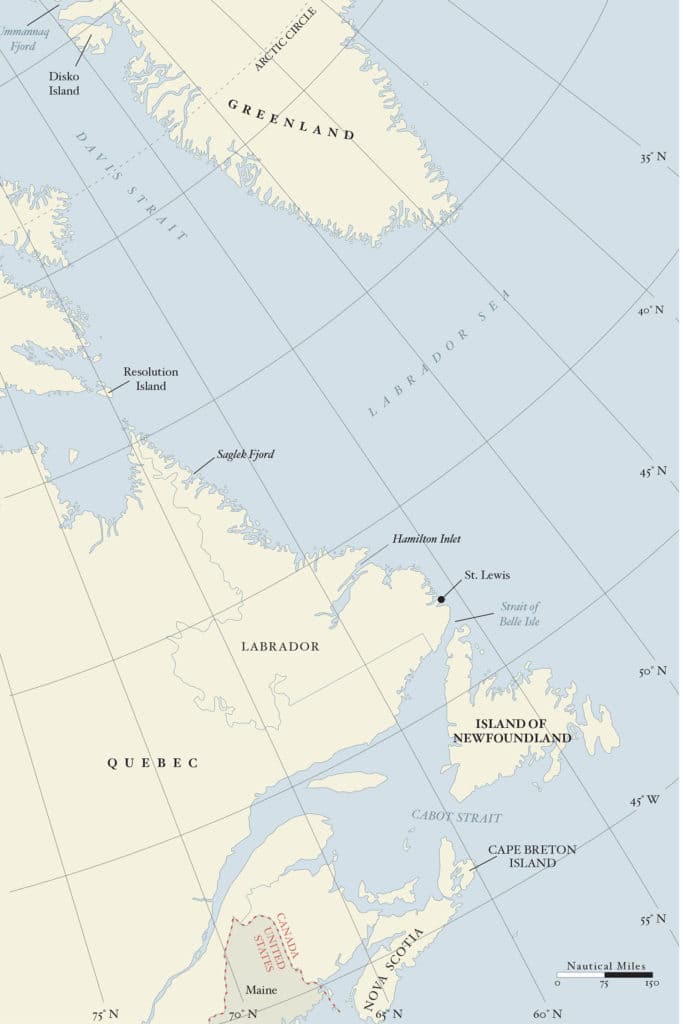
We push on northward to Uummannaq and Karrat Fjords. Wrapped in dense fog, we are grateful for the working radar. It paints a great blob not too far off, and we turn towards it in great excitement, straining our eyes to see through ghostly white vapors. All too suddenly the sea under the bow shines green. We’re afloat over a submerged tongue of ice. We are taking stupid chances. The shining wall of pure ice rises abruptly high above.
At about midday, a faint ring of the sun hovers overhead. A slight breeze shakes the steaming curtains of fog, and we begin to motor from berg to berg. Now we see them, then they’re lost. At one point, the fog dissolves into a white cloud that’s in tatters on the bergs’ peaks; next, the whole massive creation vanishes.
RELATED: Back to Greenland
For a few years now, Karrat Fjord has been the focus of Nancy’s quest for the locations that inspired the best works of Rockwell Kent. A small sailboat adventurer in his own right, Kent was one of the great American artists of the early 20th century. The powerful imagery of his 280 wood engravings illustrating the 1930 edition of Melville’s Moby Dick brought this classic of American literature from oblivion back into national attention. The boat on which he arrived in Greenland wrecked, but Kent was smitten with the grand landscapes. He spent three winters on the northwestern coast, nearby or within Karrat Fjord, creating the best of his oils.
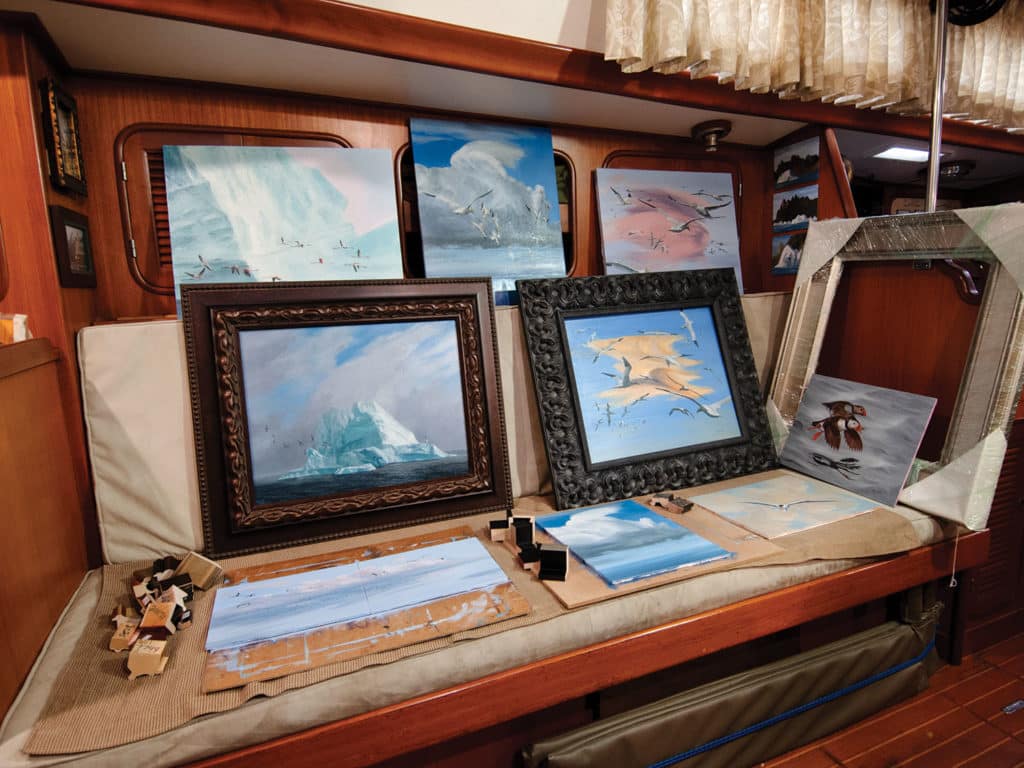
Heavy ice floes and mobs of icebergs had stopped us at the fjord before, but finally in 2016, we sit hove-to off Karrat Island. Carpets of crushed ice thicken and are too dense for our fiberglass hull to power through. This ice dampens the underlying swell, and Nancy’s easel on the bow stays straight.
There is no wind, and the sun is low but warm. Occasionally we hear the eerie clinking of ice chunks, then the silence settles down, only to be disturbed now and then by the low boom of an iceberg cracking. Far away drifts a distant odd thump: the bow cannon from a local boat out on a whale hunt.
RELATED: Chasing Icebergs in Greenland
Nancy’s ecstatic. Third time’s a charm, as they say. Glaciers flowing into the various arms of Uummannaq Fjord from the Greenland icecap launch convoys of gigantic icebergs. Majestic, beautiful and indifferent to puny humans, they had before barred the route northward. Now, the bergs satisfy the most intense desires for aesthetic gratification. It would take several lifetimes to portray the varied scenery around us, though Nancy keeps at it.
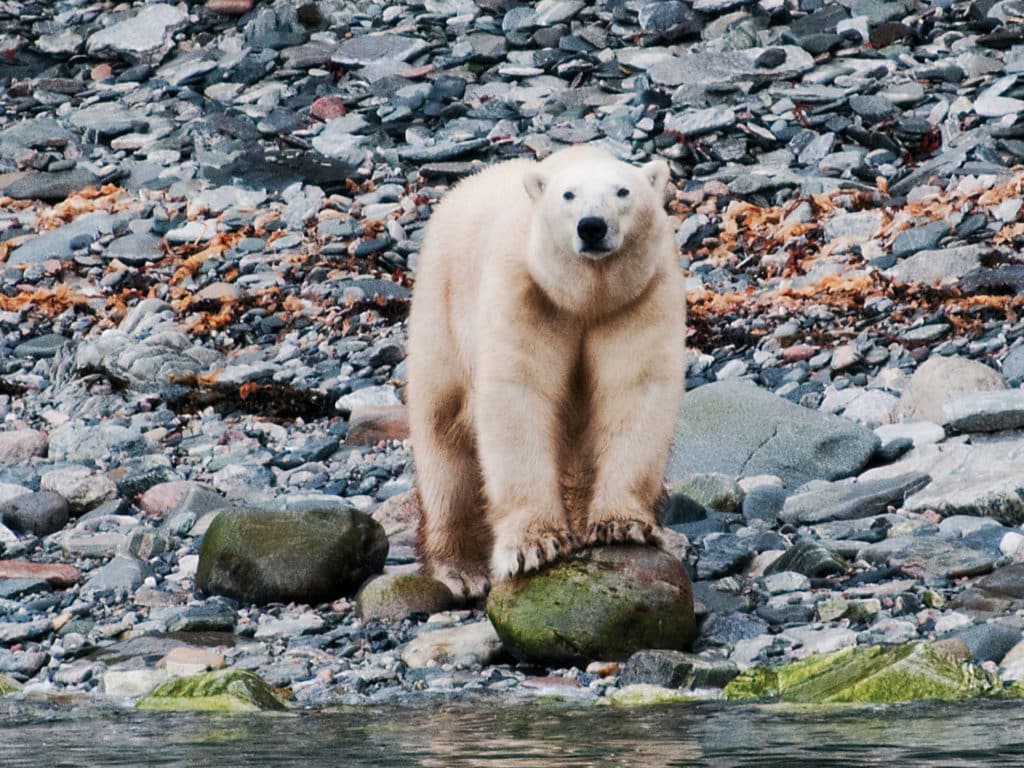
Impenetrable ice cliffs block the entrance to Uummannaq, a small harbor and the only commercial port in these waters. Luckily the ice-free anchorage at the back of Uummannaq Island supplies a front-row view of fleets of bergs in all sizes and shapes as they steam along at a knot or more. The mountains in the background, slashed by gloomy gorges and sunlit ridges, add drama.
Some miles away, on Appat Island, for the price of a scramble up a nearly vertical mountainside, we end up like birds looking down on the ice-choked fjord and across at the tops of other mountains now at eye level. We’ve come with backpacks bulging with paints, brushes and small panels for Nancy, and camera gear for me. In the far distance glows the mainland ice cap. Hours later it takes all my powers of persuasion to get Nancy to begin a return to the boat. It’s slow. Slipping and sliding, we drag panels covered with sticky paint down the mountain. The paintings acquire a texture of genuine Greenland dust.
We crash on the boat after a quick snack. It’s after midnight but you wouldn’t know it. Here in summer, above the Arctic Circle, the sun floats above the horizon 24 hours a day. Here, an artist’s life calls for stamina—it’s hard to close your eyes for fear of missing something.
In August, the sun begins to sink below the horizon. From 0200 until dawn, we levitate southward in a soft bubble of pastels, the sea and sky merging into one, the moon rising over purple mountains. Later, cutting across Baffin Bay to Resolution Island, nights return, though they’re short at first.
Under an overcast gray sky, Resolution stands bleak, a mound of ruthless, worn out rock. But next morning, the sun straining through thick fog brings colors, muted yet rich, and Nancy sets up her easel on the foredeck. Later, we begin cranking up the anchor; we look up at the near shore right into the scrutinizing stare from a massive polar bear. From now on there will be no painting on land; bears prowl the coast for seals, and a human could easily make a substitute meal.
Nancy lays aside her oils as we slowly cruise the Labrador coast south of Resolution Island and on to Saglek Fjord and beyond. This is a country of deep fjords that penetrate far into the Torngat Mountains, which stand some 5,000 feet tall in places. It’s a coast of monumental sharp headlands; their tops are bluffs, similar to the heads of sperm whales, backed by saw-toothed mountains. The shore is a study in black and white and deep grays—pen and ink country.
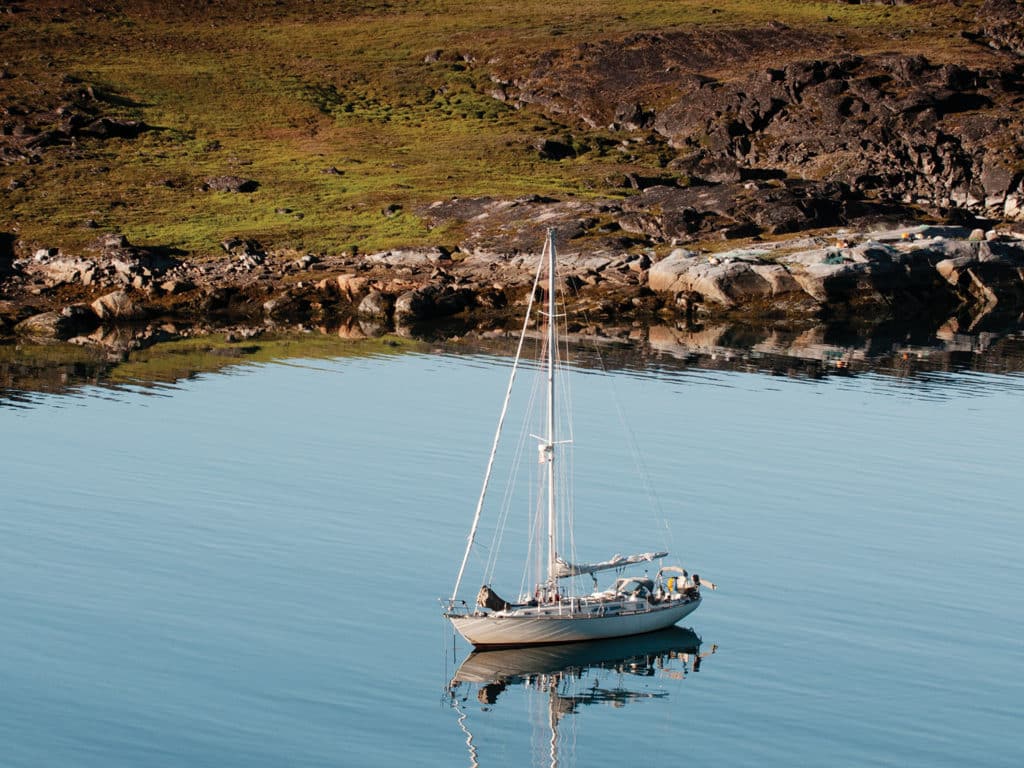
Northern Labrador is polar-bear territory. Powering outwards from Ikkudliayuk Fjord, we come along a polar bear paddling towards the mainland 12 miles away. Labrador captains report seeing these aquatic animals tens of miles offshore. With most of the ice long gone, we thought there wouldn’t be any polar bears south of Saglek Fjord. Wrong! At anchor some 80 miles south from Saglek, we are in the bunk reading, when we hear scraping on the hull and the boat heels over. A stray chunk of ice caught on the boat, I’m sure.
I jump up to the cockpit and then slide back into the cabin, even faster. “It’s a bear! White bear! Get a flare gun, make noise!” I shout.
nstead Nancy grabs a camera. As I return topside with a foghorn in hand, the bear lets go of the bulwark, its gigantic paws maybe 4 feet from us. The racket we make works. The bear’s eyes, dark, indifferent and cold, meet ours, but the animal begins to swim away, strangely diving under, surfacing, diving, surfacing, paddling farther and farther with help of the slight current. Despite failing light, we notice a good-size cub landing on the rocks, so now we know the bear is a female and probably anxious to get a rest on this handy piece of “ice”—our hull is white after all.
The sunny days north of the Arctic Circle are a distant memory. Apart from the sun jabbing down through persistent cloud cover, we don’t see much color until reaching the Finger Islands, where the 3,000-foot red-butte Kaumajet Mountains meet the sea in the middle of the Labrador coast.
The weather worsens with the advancing season. To dodge fierce winds, we sail from one protected anchorage to another. In the middle of Hamilton Inlet, the longest in Labrador, we must stop for several hours at Gannet Islands, to wait for decent weather. Despite the name, there are no gannets here—and no place to anchor either. Wise to the ways of man, Atlantic puffins, razorbills, guillemots and murres have chosen these remote specks of land to breed. From a distance, birds by the thousands rise and fall like clouds of leaves in a tornado. Closer in, these stocky divers and flyers shoot by like bullets, certainly impossible to sketch. To freeze their antics for later reference, we whip up the cameras.
Nancy uses the frequent delays on the way south to finish half-done studies. By the time we reach the west coast of Newfoundland and make it through Cabot Strait to Cape Breton Island, the main bulkhead in the saloon looks like a gallery wall. A rack holds nine more finished-but-still-drying pieces. Touching the painting in progress on the easel is strictly verboten. Getting underway takes time—folding away the easel, stowing delicate pieces in the aft cabin and the fo’c’sle.
In November, in South Carolina, we make our first long stop. The boat transforms into a framing shop. Framing 65 canvases, the result of several trips northward, will take some time, but in two months, Nancy has a solo show on Jekyll Island in Georgia. Jekyll was once a hangout for fabulously rich robber barons—we hope some of those riches remain.
For several seasons, the search for visual inspiration has taken Nancy and Tom Zydler and the Francis B on an artistic exodus to the far north. To see Nancy’s work visit zydler.com or view her paintings on Instagram: nancy_zydler.








